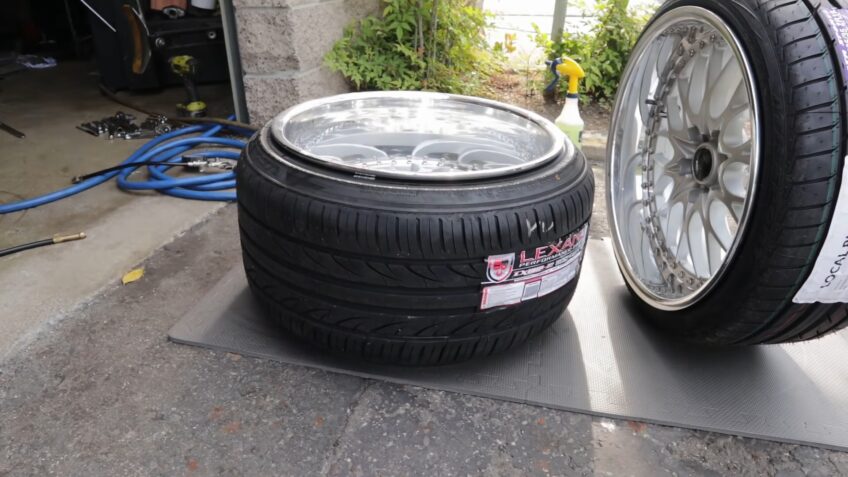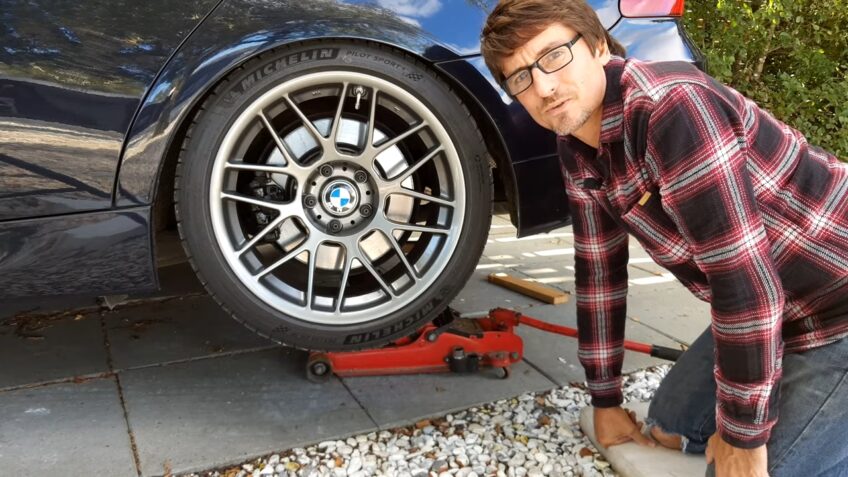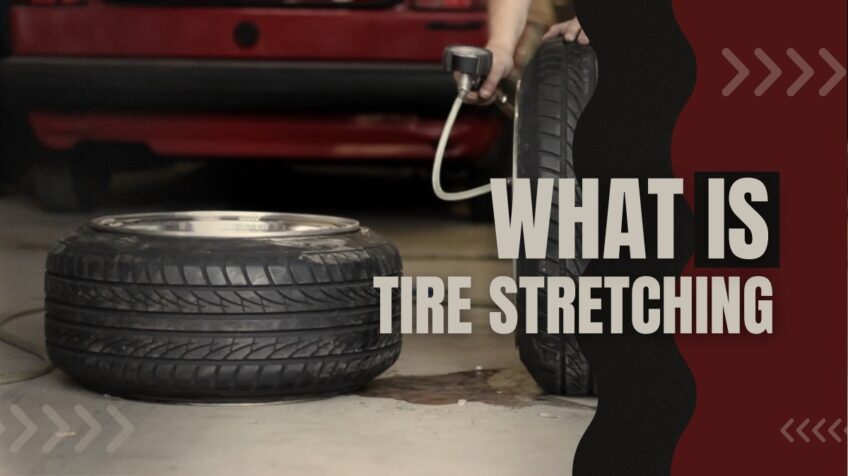Tire stretching has become a popular trend in the automotive world, particularly among car enthusiasts and modification aficionados. While some people swear by its aesthetic appeal, others are concerned about the safety and legality of the practice. This comprehensive guide aims to answer your questions about tire stretching, its potential risks, and its legality. Grab a cup of coffee and buckle up as we explore this fascinating aspect of car culture.
Overview of Tire Stretching
Tire stretching, also known as “stretched tires,” “poke,” or “stance,” refers to the practice of mounting a tire that is narrower than the recommended width for a particular wheel. This results in the tire’s sidewalls being stretched out to fit around the wheel, creating a distinct look. Tire stretching originated in the European racing circuit and gained popularity in the United States and other parts of the world as a modification trend.
Why Do People Stretch Their Tires?

There are several reasons why car enthusiasts opt for tire stretching:
1. Aesthetics
The stretched tire look is visually striking and unique. It gives vehicles a lowered, aggressive stance and can create a dramatic effect, particularly when paired with other modifications, like lowered suspension and widebody kits.
2. Fitment
Stretching tires can help accommodate wider wheels and low-offset rims without the need for fender rolling or other body modifications. This is particularly appealing for those with vehicles that have limited wheel well clearance.
3. Performance
Some drivers claim that tire stretching can improve handling and cornering performance by providing a wider contact patch and reducing sidewall flex. However, this claim is widely debated and lacks solid scientific backing.
The Risks and Dangers
Despite its visual appeal and purported performance benefits, tire stretching carries inherent risks and dangers:
- Reduced Traction: Stretching a tire reduces its contact patch with the road, potentially leading to less traction and grip, particularly in wet conditions.
- Increased Sidewall Stress: Stretching a tire places additional stress on the sidewalls, which can lead to premature wear and an increased risk of blowouts.
- Decreased Load Capacity: Stretched tires typically have a reduced load-carrying capacity, putting extra stress on the remaining tires and increasing the risk of tire failure.
- Compromised Tire Performance: The altered sidewall profile can negatively impact tire performance, particularly in terms of cornering stability and overall handling.
- Voided Warranties: Tire manufacturers typically void warranties on tires that have been stretched, as it is considered an improper use of their product.
Is It Safe?
Given the risks and dangers outlined above, tire stretching is generally considered unsafe. While some drivers may not experience any issues, the risk of tire failure or reduced performance is significant, particularly when driving at high speeds or in adverse conditions. It’s essential to consider these risks when deciding whether to stretch your tires, and to prioritize safety over aesthetics.
Is It Legal?
The legality of tire stretching varies from region to region. In the United States, there are no federal laws specifically prohibiting it. However, individual states have their own regulations regarding vehicle modifications and may require that tires meet specific performance standards or load-carrying capacities.
For instance, in California, the Vehicle Code states that tires must not have exposed cords, bulges, or other visible damage that could lead to failure. Stretched tires with visible damage would not pass this requirement, potentially resulting in fines or other penalties.
Similarly, in Europe, tire stretching may not be explicitly illegal, but it could fall under broader regulations related to vehicle safety and roadworthiness. It’s essential to research the specific laws and regulations in your area to avoid any legal issues or penalties.
Alternatives to Tire Stretching

If you’re interested in achieving a unique look or improving your vehicle’s handling without the risks associated with tire stretching, consider these alternatives:
1. Properly Sized Tires
Instead of stretching your tires, opt for wider wheels and tires that are designed to fit your vehicle’s specifications. This will provide better performance and safety while still achieving the desired aesthetic.
2. Suspension Upgrades
Upgrading your vehicle’s suspension can improve handling and provide a lowered, aggressive stance without the need for tire stretching. Consider options like coilovers, lowering springs, or air suspension systems.
3. Fender Rolling

If you’re looking to accommodate wider wheels without tire stretching, consider Fender rolling. This modification involves reshaping your vehicle’s fenders to create additional clearance for larger wheels and tires.
4. Camber Adjustment
Adjusting your vehicle’s camber can improve handling and cornering performance without the need for tire stretching. Camber refers to the angle of the wheels relative to the road, and adjusting it can provide a wider contact patch and better grip.
The Process of Tire Stretching
Now that we’ve discussed the risks, legality, and alternatives, let’s delve into the process itself. If you’re still interested in learning about how tire stretching is performed, here’s a brief overview:
1. Selection of Wheel and Tire Sizes
The first step is selecting the appropriate wheel and tire sizes. As mentioned earlier, the tire size should be narrower than the wheel width, resulting in a stretched appearance. It’s crucial to research the best size combinations for your specific vehicle and desired look.
2. Professional Installation
Tire stretching should always be performed by an experienced professional. The process involves mounting the narrow tire onto the wider wheel using specialized equipment. Proper installation is crucial to minimizing the risks.
3. Balancing and Alignment
Once the tires are mounted, they should be balanced, and the vehicle’s alignment checked. Proper balancing and alignment are essential for maintaining safe and predictable handling.
4. Regular Maintenance
Stretched tires require more frequent maintenance checks, including monitoring air pressure and inspecting for signs of wear or damage. Keeping a close eye on your stretched tires will help you identify potential issues early, reducing the risk of tire failure.
Tire Stretching and Insurance
Another important factor to consider when exploring tire stretching is its potential impact on your vehicle insurance. Many insurance companies view this process as a risky modification and may refuse coverage or charge higher premiums for vehicles with stretched tires. It’s essential to check with your insurance provider before proceeding with tire stretching to ensure you’re adequately covered.
The Role of Tire Stretching in Car Culture
Tire stretching has become a prominent aspect of car culture, particularly in the tuner and stance scenes. The aggressive, unique look of stretched tires has generated a loyal following among enthusiasts. Car shows, and online forums dedicated to this trend provide a platform for individuals to showcase their vehicles and share experiences.
However, tire stretching has also generated controversy and debate among car enthusiasts. Many argue that the risks outweigh any perceived benefits, and some view the practice as a reckless disregard for safety. This ongoing debate adds to the intrigue surrounding tire stretching and contributes to its notoriety within the automotive community.
Final Words
Tire stretching is a polarizing topic in the automotive world, with enthusiasts either loving or loathing the practice. While it may offer a unique look and claim to provide performance benefits, the associated risks and potential legal issues make it a controversial choice.
When considering this process, it’s crucial to prioritize safety and research the specific laws in your region. There are also viable alternatives to tire stretching, like proper tire sizing and suspension upgrades, that can achieve a similar aesthetic and performance outcome without the associated risks.
As a car enthusiast, the choice is ultimately yours; however, it’s essential to make informed decisions and always prioritize the safety of yourself and others on the road. Happy motoring!

